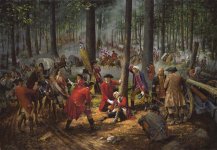The first uniform for the regiment was conceived of as almost an afterthought while the newly formed regiment was recruiting and collecting provisions for its first campaign to oust the French from the Forks of the Ohio in 1754. In March, Washington remarked upon the poor state of clothing for the regiment and requested Dinwiddie to provide a uniform for the soldiers (Brock, v.1, 92). Later in the month a uniform consisting of "a Coat and Breeches of red Cloth" (Brock, v.1, 116) was decided upon. However, it seems that not enough uniforms were obtained on such short notice, because as late as June 28 (Washington surrendered at Fort Necessity on July 3) uniforms were still being sent from Alexandria (Abbot v.1, 153-54). Therefore only part of the regiment wore the red coat, while many of the rest had checked shirts, and apparently the pants in which they arrived to the service (Abbot, v.1, 141). In a 1757 letter to the new commander of British forces in America, Lord Loudoun, Washington stated that "the first Twelve Months of their [the soldiers] Service they received no clothing" (Abbot, v.4, 86). Washington’s comment indicates that the regiment had no real uniform in 1754.
Therefore it appears that the real first uniform followed the color scheme of blue with red facings; a scheme that was followed for the regiment’s entire existence. This uniform was ordered and purchased in London through John Hanbury in the fall of 1754 and arrived in March of 1755, in time for the regiment to leave Will’s Creek (Fort Cumberland) with General Edward Braddock on the ill-fated Fort Duquesne campaign. In spite of no order for the making of the uniforms having yet been found, there are a couple of hints that lead to a conclusion that this first uniform was blue. One, is a reference of Captain Robert Orme’s, in a description of the Battle of the Monongahela, to the "Virginia blues". The other reference is in a letter from Governor Dinwiddie to Captain Robert Stewart on 26 November 1754 advising him to purchase "some cheap blue Clothing" for his men while they await the arrival of the uniforms from Britain (Brock, v.1, 413). The quality of this first uniform seems to have been something less than the expectations for a standard uniform, for Washington described this uniform to Lord Loudoun as "a suit of thin sleazy Cloth without lining, and without Waistcoats except of sorry Flannel" (Abbot, v.4, 86).
When the Regiment was reorganized after the Braddock campaign with Washington as its colonel, the first orders concerning the uniform are extant. The regimental is ordered blue with red facings, a red waistcoat, and blue breeches. However, approximately one and one-half years would pass before the soldiers received their uniforms from London. The timing was fortuitous because they arrived just as several companies were to leave for Charles Town, South Carolina to act in conjunction with the British. These uniforms were apparently impressive to the British officers because the Virginia officers received several compliments on the appearance and bearing of their soldiers (Abbot, v.4, 373).
It appears that the regiment was kept in good uniforms for the remainder of their service, except during the 1758 Fort Duquesne campaign. Because their old uniforms were literally worn out, and the new ones had not arrived from England, the regiment was authorized by General John Forbes to wear Indian clothing (hunting shirts, breechcloths, and wool leggings) for the campaign. The new uniforms arrived before the end of the campaign, just as the colder fall weather was setting in. Deserter notices describing the regimental as late as May 1762 advertise a deserter having "a blue Coat, turnup with red", thus making it likely that the regiment used the red on blue color scheme from 1754 to 1762 (Pennsylvania Gazette, 29 July 1762).


